Farin G. Curves and Surfaces for CAGD. A Practical Guide
Подождите немного. Документ загружается.

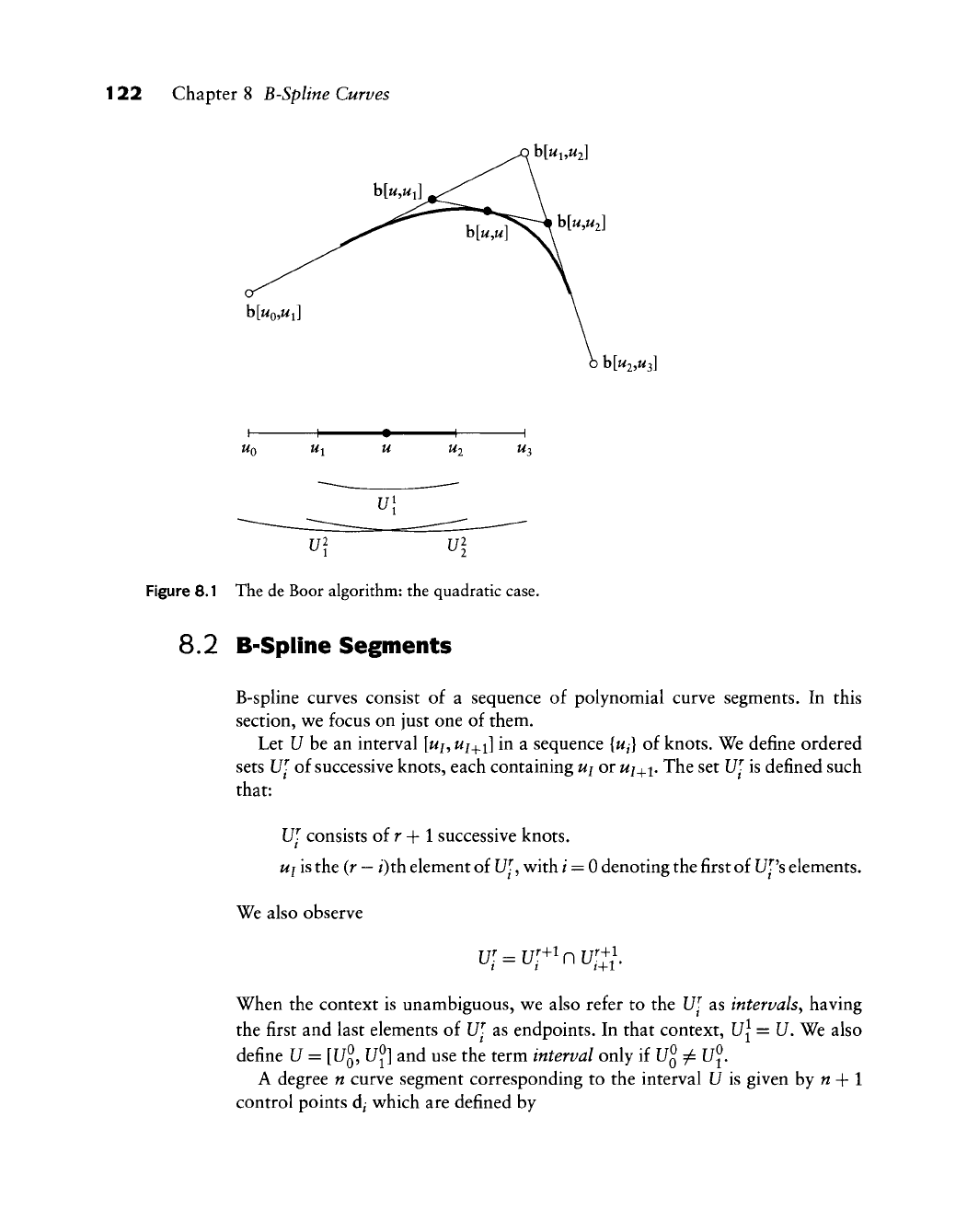
122 Chapter 8 B-Spline Curves
h[u2,u^]
Figure 8.1
1 1
UQ Ui
____^___
•
u
ul
The de Boor algorithm:
1 1
«2 ^3
the quadratic case.
8.2 B-Spline Segments
B-spUne curves consist of a sequence of polynomial curve segments. In this
section, w^e focus on just one of them.
Let U be an interval [t/j, t^/+i] in a sequence {wj of knots. We define ordered
sets W- of successive knots, each containing ui or Ui^i. The set W- is defined such
that:
W- consists of r + 1 successive knots.
ui is the (r
—
/)th element of U[, with
/
= 0 denoting the first of I7['s elements.
We also observe
u;
=
u[+inu[+/.
When the context is unambiguous, we also refer to the U[ as intervals^ having
the first and last elements of W- as endpoints. In that context, l]\ = 17. We also
define U = [Ug, Uj] and use the term interval only if
U^^U^,
A degree n curve segment corresponding to the interval U is given by « + 1
control points d^ which are defined by

8.2 B-Spline Segments 123
d,=b[Uf-l]; / = 0,...,«. (8.1)
The point x(u) = h[u^^^] on the curve is recursively computed as
d'.(u) = b[^<'^, Uf
"^"1;
r=l,,..,n;i =
0,...,n-r
(8.2)
with x(u) =
d-Qiu)?
This is knov^n as the de Boor algorithm after Carl de Boor
see
[137].
See Example 8.2 for the case n = 3 and Figure 8.2 for an illustration.
Equation (8.2) may alternatively be written as
d;(«) = (1 - Cr^dpl ^ CrM;;l; r=l,...,n;i =
0,...,n-r,
(8.3)
where
t^7('^
is the local parameter in the interval
Uf~-[~^
.
A geometric interpretation is as follows. Each intermediate control polygon
leg dp
d^-^-^
may be viewed as an affine image of
Uf_^/^
. The point d^^ is then
the image of u under that affine map.
For the special knot sequence 0^"^, 1^^^ and U =
[0,1],
the de Boor algorithm
becomes
d^(«)=b[«->,0<«—'>,l<-]; r =!,...,«;
i^O,...,n-r,
(8.4)
which is simply the de Casteljau algorithm.
If the parameter u happens to be one of the knots, the algorithm proceeds as
before, except that we do not need as many levels of the algorithm. For example,
if a quadratic curve segment is defined by
h[uQ,
u^],
b[wi, ^2]? ^Wi^ ^3] ^^^ we
want to evaluate at u = ^2? then two of the intermediate points in the de Boor
algorithm are already known, namely, h[ui,
U2]
and b[t/2,
^3].
From these two,
we immediately calculate the desired point h[u2, ^2]? thus the de Boor algorithm
now needs only one level instead of two.
Derivatives of a B-spline curve segment are computed in analogy to the Bezier
curve case (5.17)
x(u) = nh[u^''-^^,ll (8.5)
Expanding this expression and using the control point notation, this becomes
x(«) = ^(dri-d^-i), (8.6)
2 This notation is different from the one used in previous editions of this book.
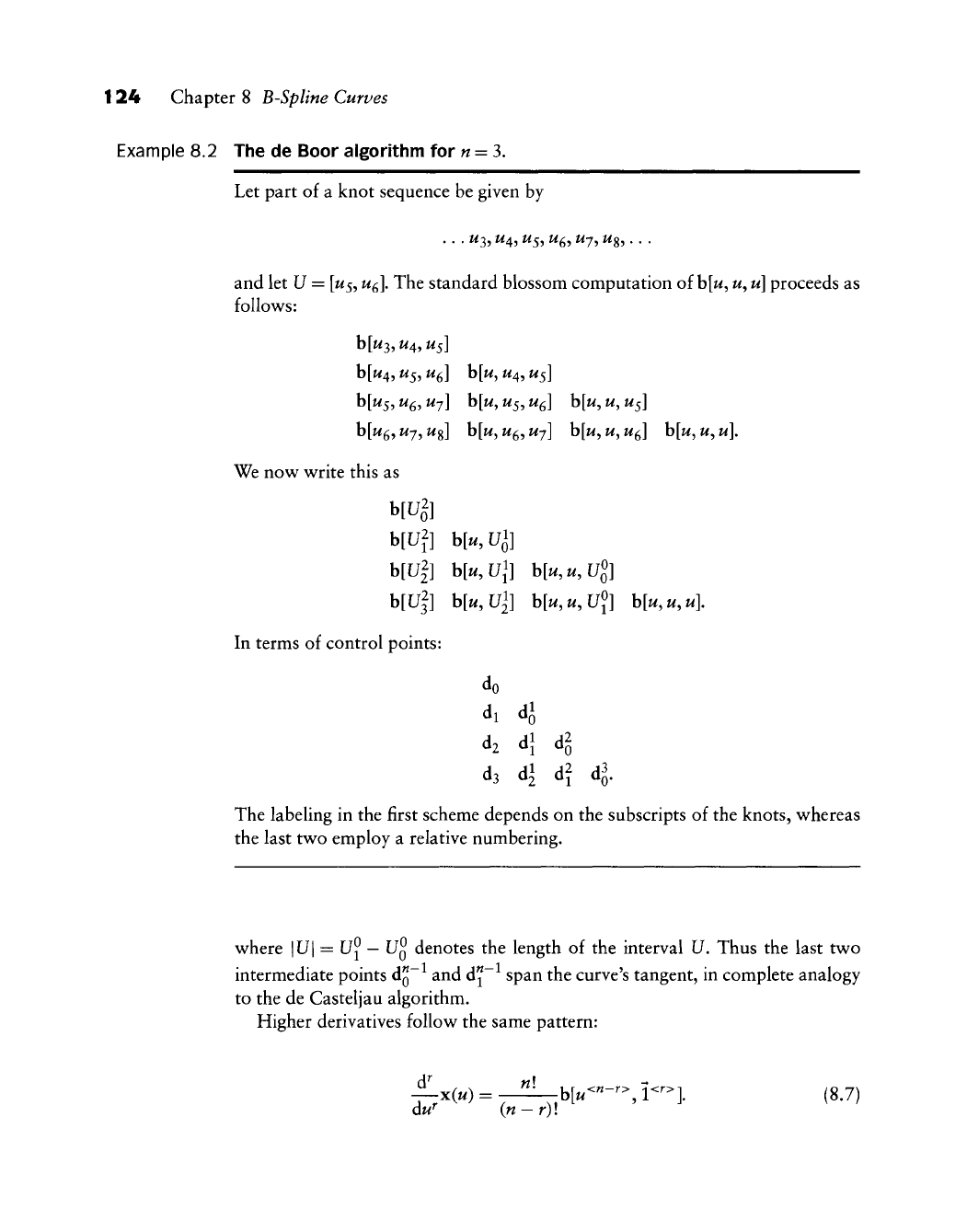
124 Chapter 8 B-Spline Curves
Example 8.2 The de Boor algorithm for « = 3.
Let part of a knot sequence be given by
. . . ^3, ^4, ^5, ^5, Wy,
Wg?
•
• •
and let U = [^5,
w^].
The standard blossom computation of
b[w,
w,
u\ proceeds as
follows:
b[W4,
^5,
U^]
h[u,
U4,
Us]
h[us,
u^,
uj] h[u.
Us,
u^]
h[u, u, us\
h[u^,uj^ug] h[u^u^^uj\ h[u,u,u^] h[u,u,u].
We now write this as
h[Uf] h[u,Ul]
b[Uf] h[u,Ul] h[u,u,U^^]
HUJ] h[u,Ul] h[u,u,U^] h[u,u,u].
In terms of control points:
dl 4
di d\
d3 dl
dl
dl dl
The labeling in the first scheme depends on the subscripts of the knots, whereas
the last two employ a relative numbering.
where \U\ = U^
—
UQ
denotes the length of the interval 17. Thus the last two
intermediate points dQ~^ and d^~ span the curve's tangent, in complete analogy
to the de Casteljau algorithm.
Higher derivatives follow the same pattern:
/-X(«) = -Jll—h[u<"-r>, l<r>l (8.7)
du^
{n
—
r)i

i.2 B-Spline Segments 125
b[W2,W3,W4]
h[u^,U4,Us]
I h[UQ,Ui,U2\
UQ U^ U2 U W3 M4 W5
m-
m
ul
ui.
Figure 8.2 The de Boor algorithm: a cubic example. The solid point is the result
h[u,
u,
u];
it is on
the line through
b[w,
w,
U2]
and
b[w,
w,
W3].
In the case of Bezier curves, we could use the de Casteljau algorithm for curve
evaluation, but we could also write a Bezier curve explicitly using Bernstein
polynomials. Since we changed the domain geometry, we will now obtain a
different explicit representation, using polynomials^ P":
x(^) = ^d,Pf(^).
(8.8)
/=o
The polynomials P" satisfy a recursion similar to the one for Bernstein polyno-
mials,
and the following derivation is very similar to that case:
3 These will later become building blocks of B-splines.
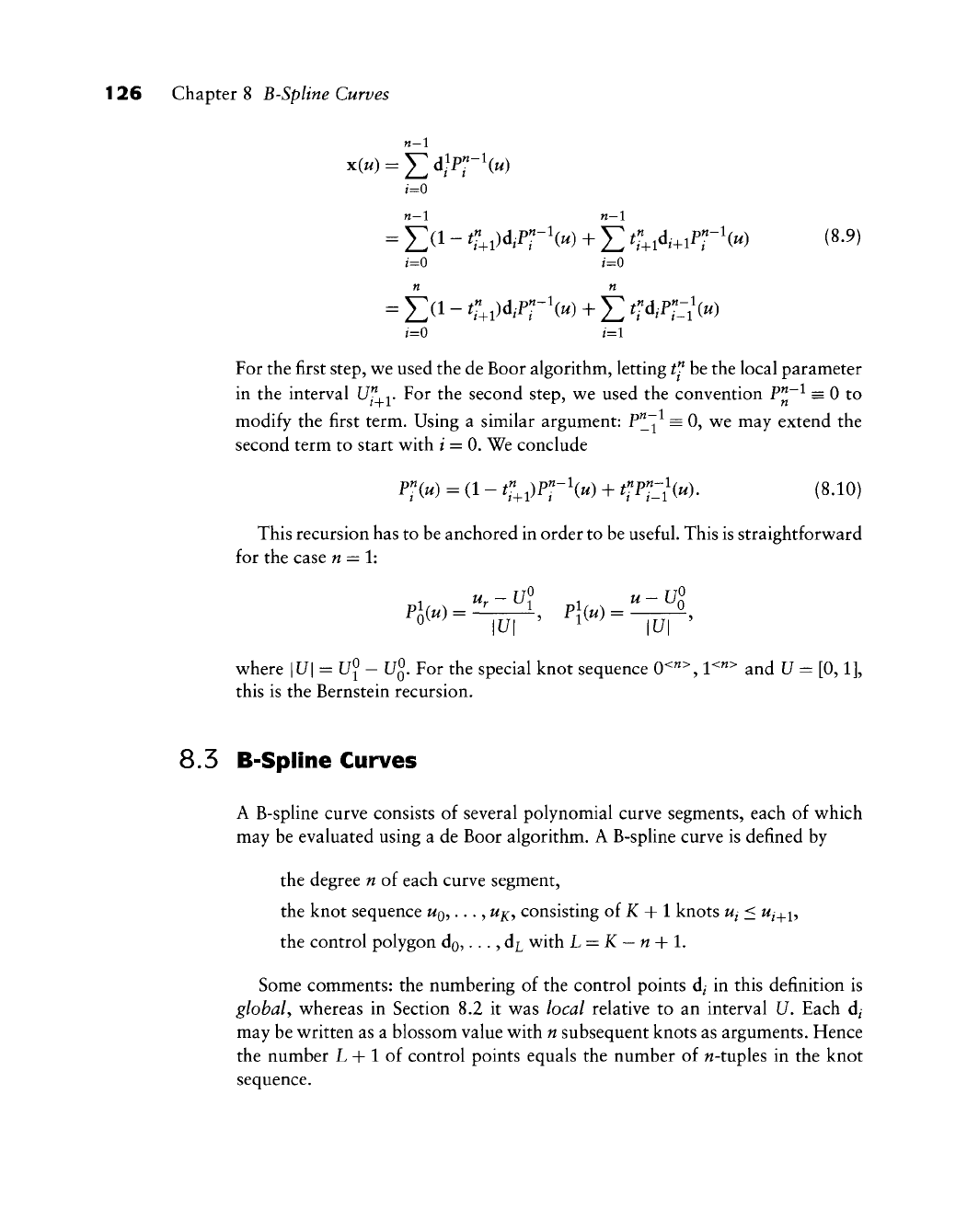
126 Chapter 8 B-Spline Curves
xiu) = J2djP^-\u)
=Ed - ti^)d,pr\^)+E
tfd^pth")
n-\
i=0
n—\
n—\
i=0 i=l
For the first step, we used the de Boor algorithm, letting tf be the local parameter
in the interval U^^^ For the second step, we used the convention P^~^ = 0 to
modify the first term. Using a similar argument: P^ = 0, we may extend the
second term to start with / = 0. We conclude
P^(u) = (1 - tl^)P'^-\u) + tfP'Izliu). (8.10)
This recursion has to be anchored in order to be useful. This is straightforward
for the case n = l:
phu) = ^,
P](u)
= ^,
ov
1^1 IV 1^1
where |U| = Uj - Ug. For the special knot sequence 0<"^, 1<"> and U =
[0,1],
this is the Bernstein recursion.
8.5 B-Spline Curves
A B-spline curve consists of several polynomial curve segments, each of which
may be evaluated using a de Boor algorithm. A B-spline curve is defined by
the degree n of each curve segment,
the knot sequence
UQ,
...
^
Uf^^
consisting of
iC
+ 1 knots
Uj
< /^/+i,
the control polygon dg,..., d^ with L = K ~ n + 1.
Some comments: the numbering of the control points d^ in this definition is
global, whereas in Section 8.2 it was local relative to an interval U. Each dj
may be written as a blossom value with n subsequent knots as arguments. Hence
the number L + 1 of control points equals the number of w-tuples in the knot
sequence.
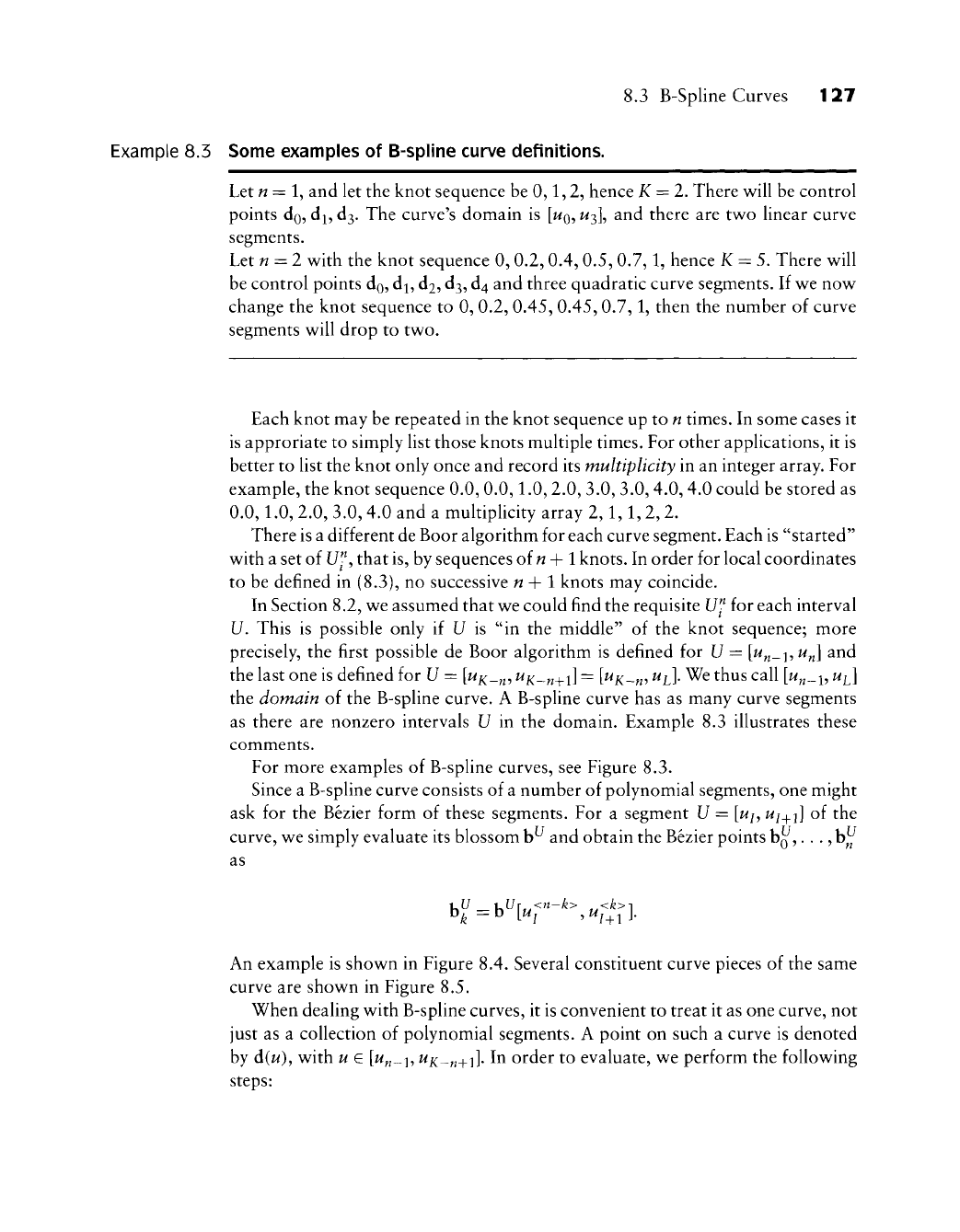
8.3 B-Spline Curves 127
Example 8.3 Some examples of B-spline curve definitions.
Let n=
1^
and let the knot sequence be 0,1,2, hence K = 2. There will be control
points do, d^,
d3.
The curve's domain is
[UQ^
U^\ and there are two linear curve
segments.
Let n = l with the knot sequence 0, 0.2, 0.4, 0.5,
0.7,1,
hence K = S. There will
be control points do, d^, d2,
d3,
A^
and three quadratic curve segments. If we now
change the knot sequence to 0, 0.2, 0.45, 0.45,
0.7,1,
then the number of curve
segments will drop to two.
Each knot may be repeated in the knot sequence up to n times. In some cases it
is approriate to simply list those knots multiple times. For other applications, it is
better to list the knot only once and record its multiplicity in an integer array. For
example, the knot sequence 0.0,0.0,1.0,2.0,3.0,3.0,4.0,4.0 could be stored as
0.0,1.0,2.0, 3.0,4.0 and a multiplicity array 2,1,1,2,2.
There is a different de Boor algorithm for each curve segment. Each is "started"
with a set of
U^",
that is, by sequences o{n-\-l knots. In order for local coordinates
to be defined in (8.3), no successive
w
+ 1 knots may coincide.
In Section 8.2, we assumed that we could find the requisite V^ for each interval
U. This is possible only if U is "in the middle" of the knot sequence; more
precisely, the first possible de Boor algorithm is defined for U = [u^-i-, u^ and
the last one is defined for U =
WK-n->
^X-w+il = Wx-m
^LI-
^^ ^^^^
^^11
Wn-h
^LI
the domain of the B-spline curve. A B-spline curve has as many curve segments
as there are nonzero intervals U in the domain. Example 8.3 illustrates these
comments.
For more examples of B-spline curves, see Figure 8.3.
Since a B-spline curve consists of a number of polynomial segments, one might
ask for the Bezier form of these segments. For a segment U = [uj, uj^i] of the
curve, we simply evaluate its blossom b^ and obtain the Bezier points h^,. . ., b^
as
j^
=b [Uj , Uj^^ J.
An example is shown in Figure 8.4. Several constituent curve pieces of the same
curve are shown in Figure 8.5.
When dealing with B-spline curves, it is convenient to treat it as one curve, not
just as a collection of polynomial segments. A point on such a curve is denoted
by d(w), with u e [u^-i-,
uj^_^_^i].
In order to evaluate, we perform the following
steps:
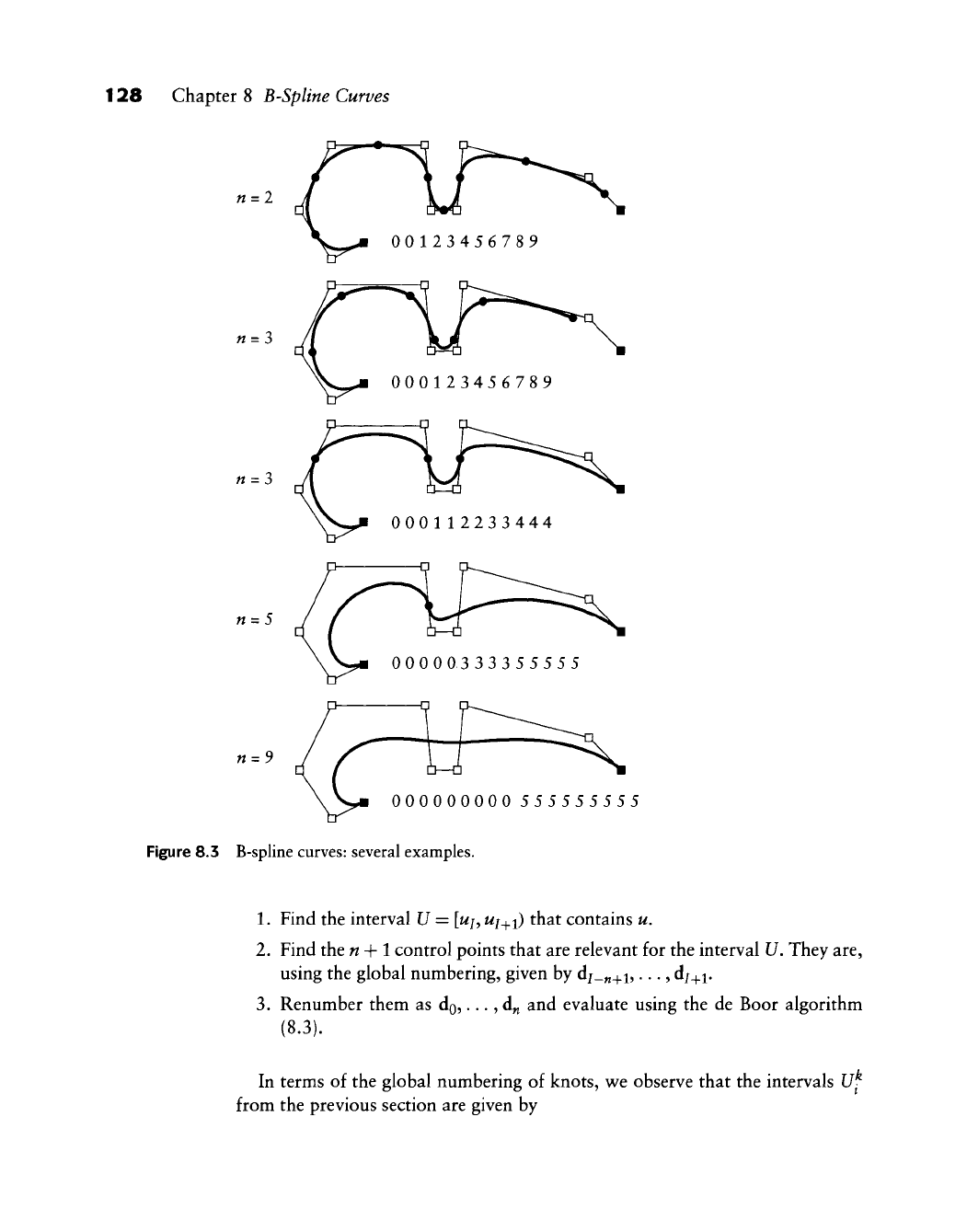
128 Chapter 8 B-Spline Curves
\^ 00123456789
n
=
3
n
=
3
n
=
5
n
=
9
000000000 555555555
Figure 8.3 B-spline curves: several examples.
1.
Find the interval U = [uj,
ui_^i)
that contains u,
2.
Find the n-\-l control points that are relevant for the interval U, They are,
using the global numbering, given by dj_„_^i,...,
d/.^!.
3.
Renumber them as do,..., d„ and evaluate using the de Boor algorithm
(8.3).
In terms of the global numbering of knots, w^e observe that the intervals U^
from the previous section are given by
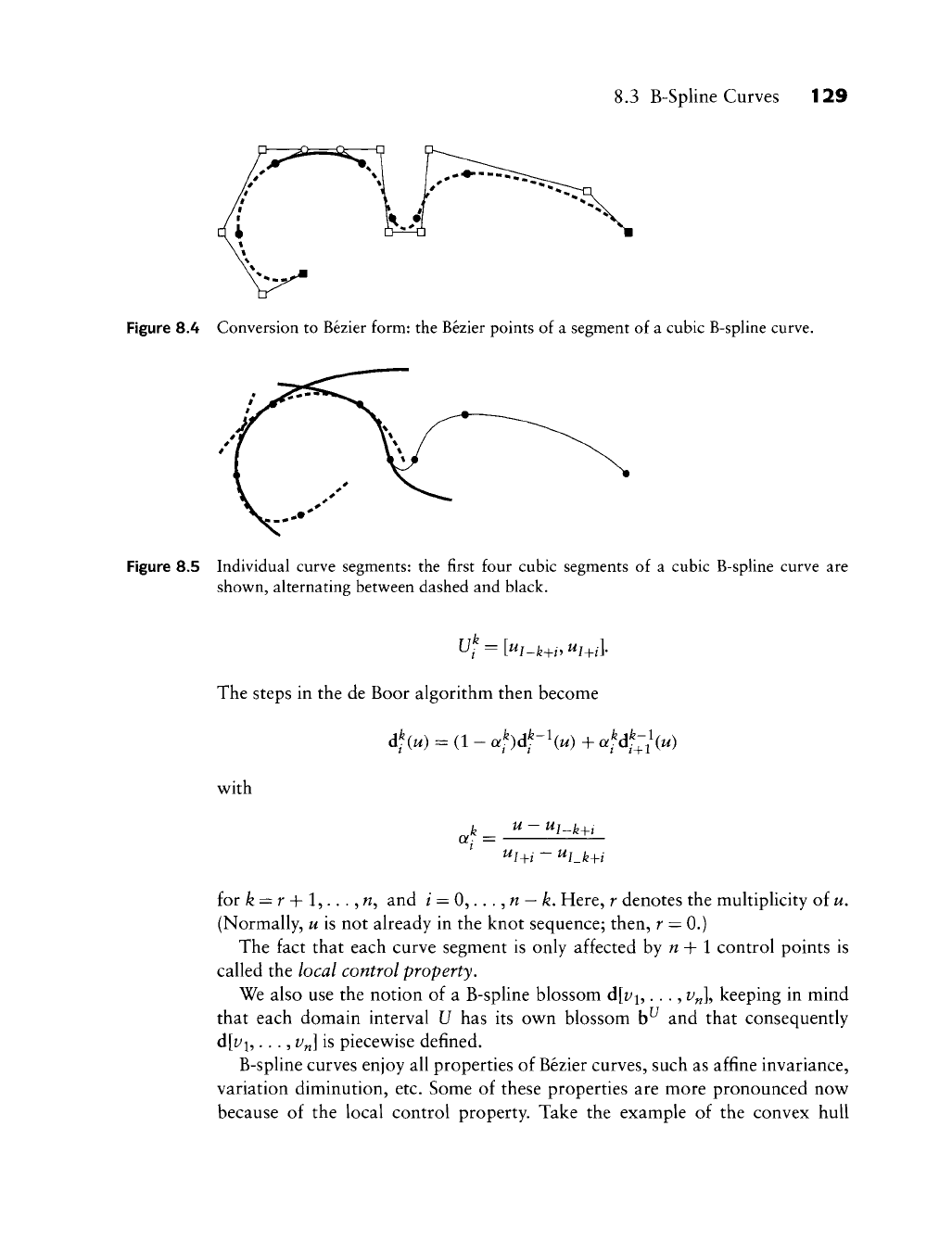
8.3 B-Spline Curves 129
Figure 8.4 Conversion to Bezier form: the Bezier points of a segment of a cubic B-spline curve.
Figure 8.5 Individual curve segments: the first four cubic segments of a cubic B-sphne curve are
shown, ahernating between dashed and black.
The steps in the de Boor algorithm then become
d^iu) = (1 - af)d^-\u) + afd^-/(«)
with
k^ ^ - ^l-k+i
^IM ~ ^l_k+i
for ^ = r + 1,.. .,
w,
and / = 0,.. .,
w —
^. Here, r denotes the multiplicity of u,
(Normally, u is not already in the knot sequence; then, r = 0.)
The fact that each curve segment is only affected by
w
+ 1 control points is
called the local control property.
We also use the notion of a B-spline blossom d[t'i,..., f
„],
keeping in mind
that each domain interval U has its ov^n blossom b^ and that consequently
d[^'i,...,
f „] is piecewise defined.
B-spline curves enjoy all properties of Bezier curves, such as affine invariance,
variation diminution, etc. Some of these properties are more pronounced now
because of the local control property. Take the example of the convex hull
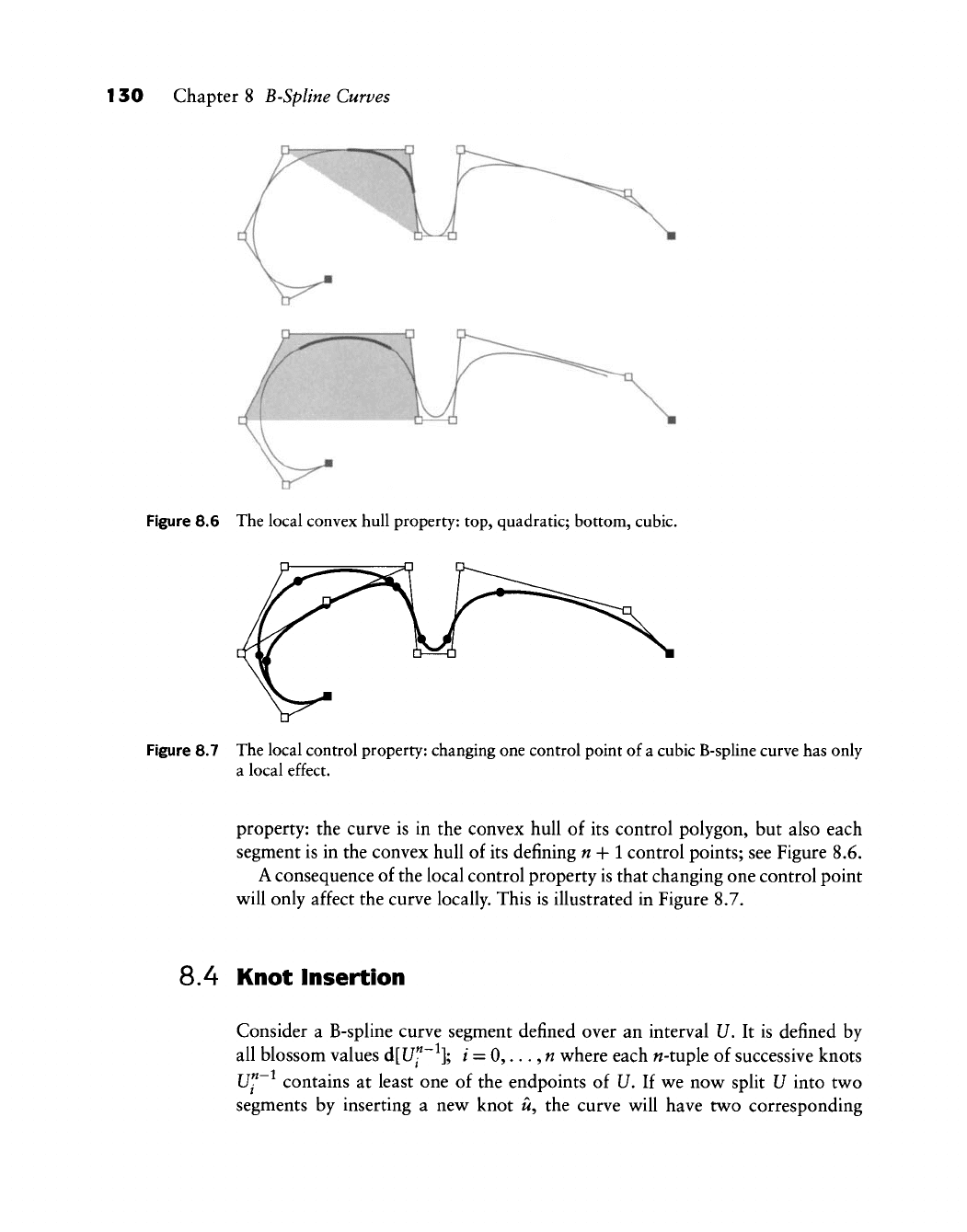
1 30 Chapter 8 B-Spline Curves
Figure 8.6 The local convex hull property: top, quadratic; bottom, cubic.
Figure 8.7 The local control property: changing one control point of a cubic B-spline curve has only
a local effect.
property: the curve is in the convex hull of its control polygon, but also each
segment is in the convex hull of its defining n-\-l control points; see Figure 8.6.
A consequence of the local control property is that changing one control point
w^ill only affect the curve locally. This is illustrated in Figure 8.7.
8.4 Knot Insertion
Consider a B-spline curve segment defined over an interval U. It is defined by
all blossom values d[[7"~ ]; / =
0,...,«
w^here each «-tuple of successive knots
U^ contains at least one of the endpoints of U. If we now split U into two
segments by inserting a new knot ii, the curve will have two corresponding
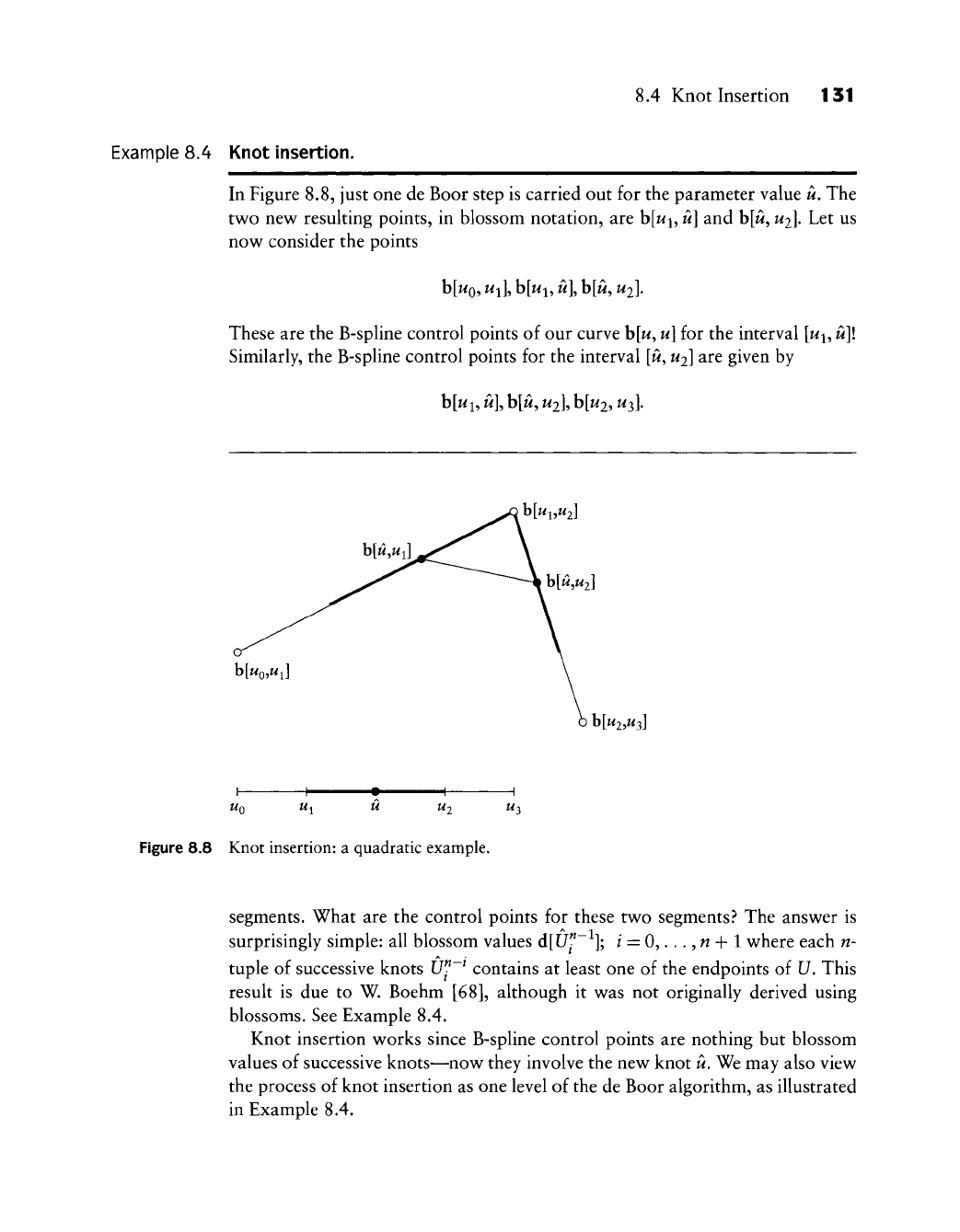
8.4 Knot Insertion 131
Example 8.4 Knot insertion.
In Figure 8.8, just one de Boor step is carried out for the parameter value u. The
two new resulting points, in blossom notation, are b[wi, u] and b[ii,
U2\.
Let us
now consider the points
These are the B-spline control points of our curve b[w,
u]
for the interval [wj, u\\
Similarly, the B-spline control points for the interval [ii,
Uj}
are given by
h[u,U2]
bK,Wi
h[U2,U^]
H
UQ Ui U U2 ^3
Figure 8.8 Knot insertion: a quadratic example.
segments. What are the control points for these two segments.^ The answer is
surprisingly simple: all blossom values
d[l7^"~^];
/ = 0,...,
w
+ 1 where each n-
tuple of successive knots U^~^ contains at least one of the endpoints of U. This
result is due to W. Boehm [68], although it was not originally derived using
blossoms. See Example 8.4.
Knot insertion works since B-spline control points are nothing but blossom
values of successive knots—now they involve the new knot u. We may also view
the process of knot insertion as one level of the de Boor algorithm, as illustrated
in Example 8.4.
